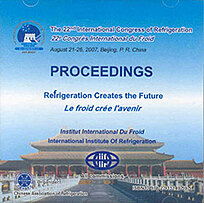
Document IIF
Modélisation d'un système à adsorption pour les applications de conditionnement d'air automobile fonctionnant à la chaleur récupérée : premier bilan de la performance.
Modelling of an adsorption system for automotive air-conditioning applications driven by engine waste heat: first assessment of performance.
Auteurs : CORBERÁN J. M., CORTÉS L., MOLA S., et al.
Résumé
This paper presents the main characteristics of an innovative cooling system for automotive applications as well as a first assessment of results obtained with a specifically developed overall model. The system consists of a water- silica-gel adsorption-desorption system, which employs the waste heat from the engine to produce the cooling of the vehicle cabin. The developed global model is completely dynamic and is able to: reproduce the operation of the engine through a standard driving cycle; evaluate the waste heat available at the engine hydraulic loop and at the exhaust gases; calculate the sequential operation of a two-reactors adsorption-desorption system, calculate the condensed water per cycle; the cooling effect produced at the evaporator; and finally, the temperature and humidity evolution of the air inside the cabin. The first assessment of results shows that the system could be able to provide for a significant amount of the required cooling.
Documents disponibles
Format PDF
Pages : ICR07-B2-850
Disponible
Prix public
20 €
Prix membre*
Gratuit
* meilleur tarif applicable selon le type d'adhésion (voir le détail des avantages des adhésions individuelles et collectives)
Détails
- Titre original : Modelling of an adsorption system for automotive air-conditioning applications driven by engine waste heat: first assessment of performance.
- Identifiant de la fiche : 2008-0840
- Langues : Anglais
- Source : ICR 2007. Refrigeration Creates the Future. Proceedings of the 22nd IIR International Congress of Refrigeration.
- Date d'édition : 21/08/2007
Liens
Voir d'autres communications du même compte rendu (839)
Voir le compte rendu de la conférence
Indexation
-
Experimental investigation on a novel four-bed ...
- Auteurs : NG K. C., CHUA H. T., WANG J. B., et al.
- Date : 04/12/2002
- Langues : Anglais
- Source : Green breeze from Asia: frontiers of refrigerants, heat transfer and system.. ACRA-2002. Proceedings of the Asian conference on refrigeration and air conditioning.
Voir la fiche
-
Numerical and experimental investigations on a ...
- Auteurs : JA K. M., CHOON N. K., YAP C., et al.
- Date : 21/08/2007
- Langues : Anglais
- Source : ICR 2007. Refrigeration Creates the Future. Proceedings of the 22nd IIR International Congress of Refrigeration.
- Formats : PDF
Voir la fiche
-
Study on a three-bed adsorption chiller with ma...
- Auteurs : AKISAWA A., KHAN M. Z. I., KASHIWAGI T., et al.
- Date : 21/05/2006
- Langues : Anglais
- Source : ACRA-2006. Proceedings of the 3rd Asian conference on refrigeration and air conditioning.
Voir la fiche
-
Multi-bed multi-stage adsorption refrigeration ...
- Auteurs : ALAM K. C. A., AKAHIRA A., HAMAMOTO Y., et al.
- Date : 04/12/2002
- Langues : Anglais
- Source : Green breeze from Asia: frontiers of refrigerants, heat transfer and system.. ACRA-2002. Proceedings of the Asian conference on refrigeration and air conditioning.
Voir la fiche
-
Design and performance analysis of function pro...
- Auteurs : QIN F., CHEN J. P., LU M. Q., et al.
- Date : 29/05/2006
- Langues : Anglais
- Source : 7th IIR-Gustav Lorentzen Conference on Natural Working Fluids (GL2006). Proceedings
- Formats : PDF
Voir la fiche
